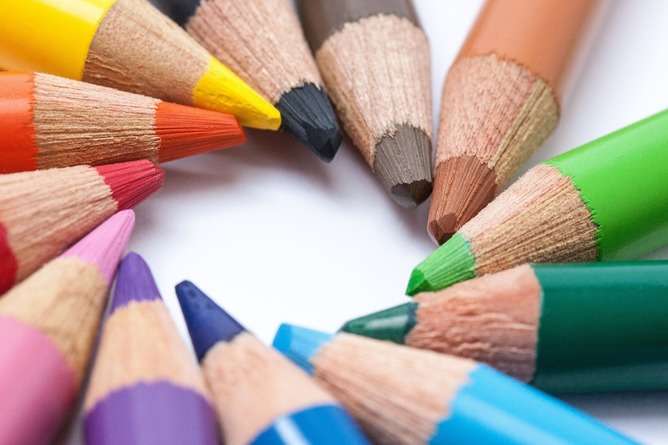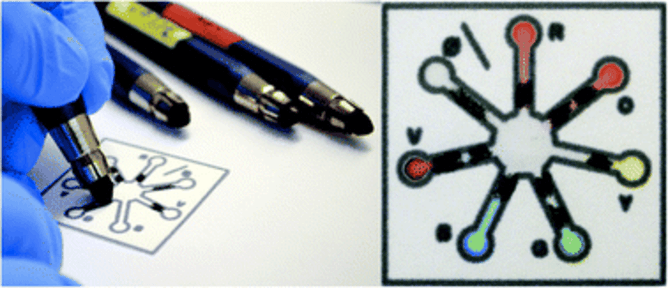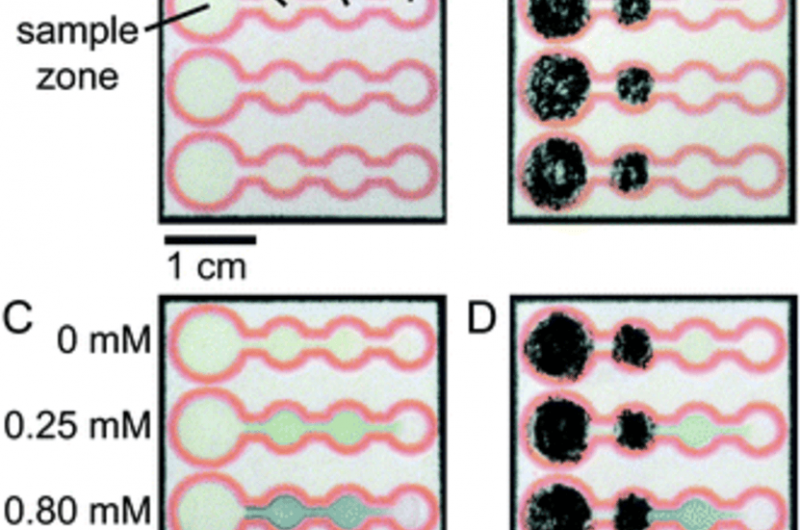Chemistry set pencils can turn life-saving tests into child's play

If you've ever sat opposite a doctor and wondered what she was scribbling on her notepad, the answer may soon not only be medical notes on your condition, but real-time chemical preparations for an instant diagnostic test.
Thanks to the work of a team of researchers from California Polytechnic State University, recently published in the journal Lab on a Chip, chemicals formed into pencils can be made to react with one another by simply drawing with them on paper. The team may have taken inspiration from colouring books for their take on a chemical toolkit, but their approach could make carrying out simple but common diagnostic tests based on chemical reactions – for example diabetes, HIV, or tests for environmental pollutants – much easier.
The project started with an established technique called paper-based microfluidics. This uses the capillary effect of paper to carefully mix together what are called reagents – those chemicals mixed to form a reaction, or to measure the presence or absence of a substance. The capillary effect in action is easily seen by dropping two inks of different colours onto a piece of tissue paper. As the liquid is absorbed by the paper the colour drops spread out until they merge with one another and form a colour blend. In the same way two or more reagents can be mixed with water on a strip of paper.
In this case, the difference is that the reagents aren't added to the paper via droplets. Instead they're applied via pencils, meaning that without specialist equipment anyone can set about creating chemical reactions by simply using them on the paper.

The team made the reagent pencils by pulverising a mixture of graphite (just as you'd find in normal pencils), test reagents and polyethylene glycol, which helps to keep the reagent dispersed throughout the mixture, as is used for the same reason in toothpaste. They compressed the mixture into pellets and mounted them into mechanical pencil holders bought from the high street stores.
The reaction paper pad was created by using a waxy ink to print small connected enclosures onto filter paper. The reagent pencils could be used to colour in these areas within the enclosures – when water was added to the paper, the reagents dissolved and, confined by the waxy ink, were forced to diffuse towards one another and react.
Real world uses for real world problems
The team demonstrated a potential use of the reagent pencil technique by using it in place of a common test used by diabetics to check their blood glucose levels, which involves reacting a pinprick blood sample with a chemical solution and examining the result.

One pencil was constructed with a mixture of enzymes, one called horseradish peroxidase (HRP) and the other glucose oxidase (GOx). A second pencil contained a reagent called ABTS. When combined in the presence of glucose these react together to give a blue-coloured product. Comparing the results from their pencils on the pad with the more traditional dropper method used by diabetics the team found the results were identical.
The image shows, on the left, the reagents applied via droplets of solution. On the right, the reagent pencils were used. The top row shows the paper at the beginning of the test, the bottom row the result. Applied to the left enclosure, the sample solution carries the two reagents together which react. The coloured product produced is, as shown on the graph, identical between the two methods.
This is of course extremely easy to set up. Traditional diagnostic tests require training, while this pad and pencil system requires no more than skill than required to colour within the lines. The reagents are extremely stable once made into pencils – usually they would degrade in a matter of days as liquids, limiting how and where the tests can be made. However the reagent pencils showed no sign of degrading after two months.
So this pencil tool kit has obvious advantages: a kit of reagent pencils, much like a box of colouring pencils, is easily transported, without the chemicals degrading. Kits could be designed with particular tests in mind – and the reaction mix can be adjusted by applying more or less, without the need or equipment to make-up complex solutions. There's scope to monitor environmental pollutants, carry out diagnostic tests in remote locations – not to mention teach chemistry in primary schools.
Source: The Conversation
This story is published courtesy of The Conversation (under Creative Commons-Attribution/No derivatives).![]()



















